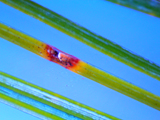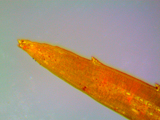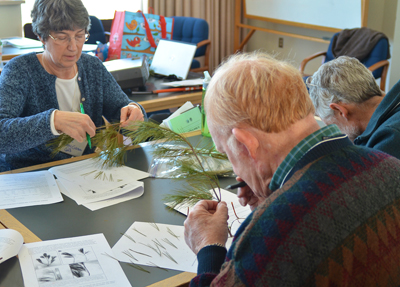March 2013
White Pines Show Continued Stress
FOREST WATCH TREES across New England continued to show a loss of second and third-year needles, our most recent Data Book finds. For the first time since the early 1990s, needles also show water stress and premature aging.
Forest Watch schools first noticed the loss of needles on 2010 needles which they studied in the 2010-2011 school year. During the 2011-2012 school year, 2011 needles showed some improvement but still less than at any time in 22 years of Forest Watch studies.
Dr. Barrett Rock, director of Forest Watch, told teachers at the Annual Forest Watch Meeting that these measurements are quite unusual and signal some major stress among the pines. Dr. Rock congratulated the teachers and their students for their role in discovering this important change in pine health (Read more…).
U.S. Forest Service plant pathologist Dr. Isabel Munck and a team from state laboratories in Vermont, New Hampshire and Maine have identified three and perhaps six different fungi which cause needle cast. (Read more…).
The pathologists admit that normally these fungi cause very little damage to white pines. Dr. Rock and our Forest Watch team believe that some other stressor has made the pines susceptible to the fungi.
Air pollution, individual oxidants or a mix of air pollutants may be coming to New England skies from widespread wild fires. Changing atmospheric conditions, especially lengthy winter inversions, may hold the pollutants in our atmosphere long enough to cause damage. (Read more…)
More study is needed. Forest Watch teachers tried and critiqued a new method of counting needle retention (Read more…). Schools may also want to test needles for the presence of fungi (Read lab instructions…).
Wes Blauss Receives Gary Lauten Award WES BLAUSS, a 6th grade science teacher at Hanson Middle School, Hanson, MA, was awarded the Gary N. Lauten award this February. The award recognizes Wes's outstanding work with Forest Watch.
Barry Rock presented Wes with a certificate of appreciation and a Forest Watch walking stick. Wes and his team of 6th grade teachers teach 150 students each year. A superb manager and an enthusiastic teacher, Wes is able to take 50 students out of doors in a single period. As some students collect samples from the Hanson School pines, others record needle and fascicle length, measure tree height and describe how the trees have changed in the past year. Every single student is engaged.
The Forest Watch walking stick was carved and incised with the Forest Watch logo by Mike Gagnon, former Forest Watch coordinator and now a Forest Watch teacher himself at Alvirne Technical School, Hudson, NH.
Gary Lauten was a former Air Force lieutenant colonel who served as the Forest Watch program coordinator from 1992-1999. Gary died in 2001. In 2002, the program began recognizing teachers who best exemplify Lauten's devotion to Forest Watch's long-term goals.
Dr. Rock notes that the annual award recognizes Lauten's commitment to making science accessible in the pre-college classroom. "Gary loved the program and became its heart and soul. And teachers love the program because it integrates biology with physics, math, Earth science, and chemistry."
More than 20 teachers attended Forest Watch's annual meeting recently in Durham. In the past year, students and teachers measured more than 8,000 pine needles and calculated their health and damage by ozone with over 1,200 different mathematical calculations.
Blauss said he was delighted to receive the Lauten award. He plans to retire in June but he has volunteered to continue helping Forest Watch as a mentor to new teachers. He will be able to visit schools in Massachusetts and southern New England to help Forest Watch teachers and students.
Summer Workshop: August 6, 7, and 8, 2013
University of New Hampshire, DurhamFOREST WATCH will welcome new teachers to a three-day workshop to be held on August 6, 7 and 8, 2013.
Teachers will learn how to set up a Forest Watch study site, how to conduct field measurements of white pines and how to collect samples of pine needles. The class will explain the science behind pine health and tropospheric ozone.
Teachers will construct their own field equipment and practice laboratory protocols. The workshop will also introduce teachers to the physics of light, spectral measurements of tree health, and the use of remote sensing imagery in monitoring their school sites.
The three-day workshop will cost $600. Participants will receive 24 hours of professional development credit or 2.4 continuing education credits.
To Register: download the WORKSHOP REGISTRATION FORM and mail completed form, with payment, to Ms. Belinda Camire, Morse Hall 355, 8 College Road, UNH, Durham, NH 03824.
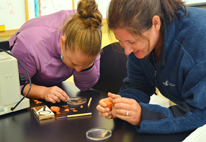 |
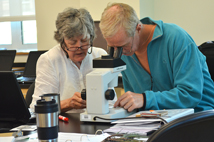 |
 |
| Teachers at the 2012 Forest Watch Summer Workshop held at the University of New Hampshire. Photos by Kristi Donahue, UNH-EOS. | ||
Teacher Enrichment Day: June 27, 2013
Morse Hall, University of New Hampshire
SCHOOL'S OUT! Take in a breath of fresh, scientific air with a day on campus. Meet scientists, visit their laboratories, find out about amazing new research. Last year our visiting teachers learned about Arctic methane bubbles, ancient terra preta in the Amazon, glacial ice cores, and the information in isotopes in their own fingernails. This year, our adventures will take you from fungal wonders in school yard soil to the solar corona. Free.
Forest Watch Student Convention: May 31, 2013,
Morse Hall, University of New Hampshire BRING YOUR STUDENTS and parent chaperones to UNH to show their research posters. We'll help you and the students build the posters regarding this spring's Forest Watch studies. We will print and hang them in Morse Hall. Students will explain their posters to UNH scientists.
After the student presentations, you will be invited to tour interesting laboratories and meet young researchers on campus. Have lunch at Holloway Commons. You pay for your transportation. Lunch at the MUB is $5 per person (Forest Watch provides a $3.50 subsidy).


